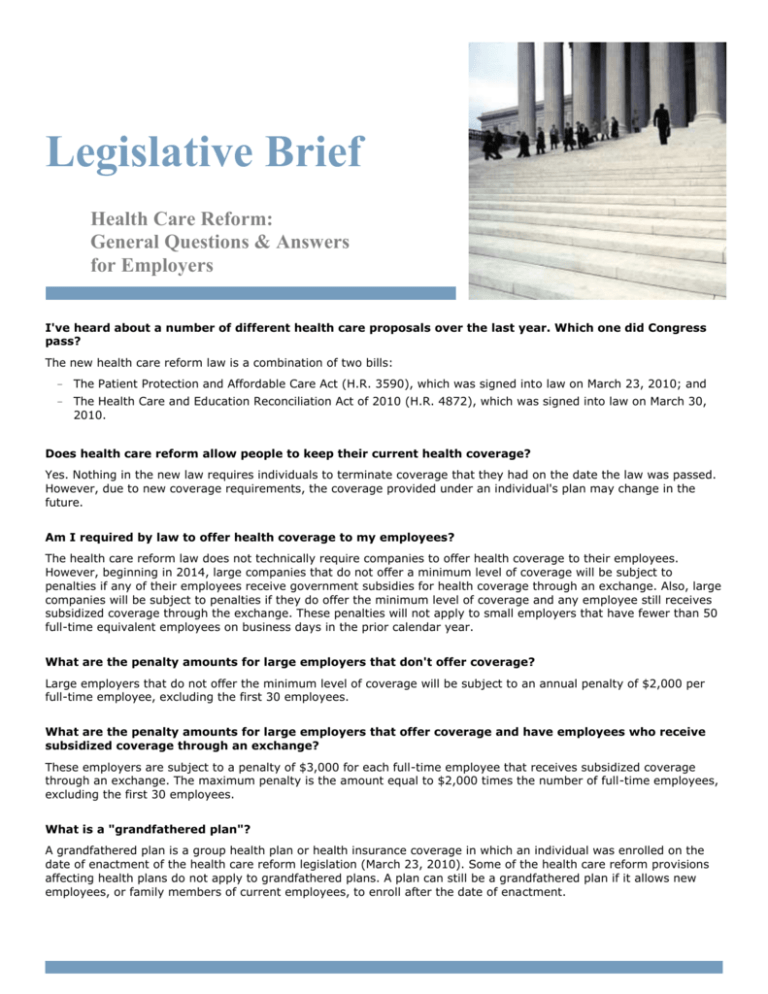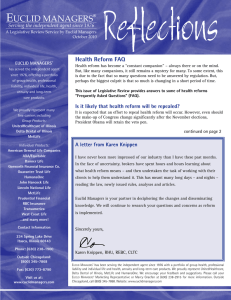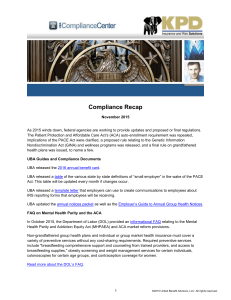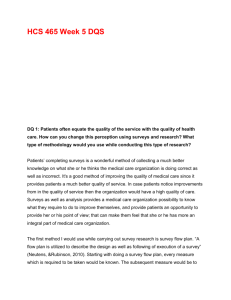
Legislative Brief
Health Care Reform:
General Questions & Answers
for Employers
I've heard about a number of different health care proposals over the last year. Which one did Congress
pass?
The new health care reform law is a combination of two bills:
- The Patient Protection and Affordable Care Act (H.R. 3590), which was signed into law on March 23, 2010; and
- The Health Care and Education Reconciliation Act of 2010 (H.R. 4872), which was signed into law on March 30,
2010.
Does health care reform allow people to keep their current health coverage?
Yes. Nothing in the new law requires individuals to terminate coverage that they had on the date the law was passed.
However, due to new coverage requirements, the coverage provided under an individual's plan may change in the
future.
Am I required by law to offer health coverage to my employees?
The health care reform law does not technically require companies to offer health coverage to their employees.
However, beginning in 2014, large companies that do not offer a minimum level of coverage will be subject to
penalties if any of their employees receive government subsidies for health coverage through an exchange. Also, large
companies will be subject to penalties if they do offer the minimum level of coverage and any employee still receives
subsidized coverage through the exchange. These penalties will not apply to small employers that have fewer than 50
full-time equivalent employees on business days in the prior calendar year.
What are the penalty amounts for large employers that don't offer coverage?
Large employers that do not offer the minimum level of coverage will be subject to an annual penalty of $2,000 per
full-time employee, excluding the first 30 employees.
What are the penalty amounts for large employers that offer coverage and have employees who receive
subsidized coverage through an exchange?
These employers are subject to a penalty of $3,000 for each full-time employee that receives subsidized coverage
through an exchange. The maximum penalty is the amount equal to $2,000 times the number of full-time employees,
excluding the first 30 employees.
What is a "grandfathered plan"?
A grandfathered plan is a group health plan or health insurance coverage in which an individual was enrolled on the
date of enactment of the health care reform legislation (March 23, 2010). Some of the health care reform provisions
affecting health plans do not apply to grandfathered plans. A plan can still be a grandfathered plan if it allows new
employees, or family members of current employees, to enroll after the date of enactment.
Legislative Brief
Health Care Reform: General Questions & Answers for Employers
How does health care reform affect grandfathered plans?
Grandfathered plans are exempt from certain insurance market reforms and coverage mandates included in the health
care reform legislation and have delayed compliance dates for other provisions. The excepted provisions are found in
Subtitles A and C of the Patient Protection and Affordable Care Act (PPACA).
Specifically, grandfathered plans are not required to: provide first dollar coverage of preventive care; permit selection
of any available participating primary care provider; comply with limits on preauthorization requirements out-ofpocket expenses or cost-sharing; satisfy nondiscrimination rules for fully-insured plans, establish a new appeals
process; or meet guaranteed issue or renewal of coverage mandates.
However, some of the health insurance industry reforms apply to grandfathered plans as well as new plans. These
reforms include prohibitions on lifetime and annual limits, pre-existing condition exclusions, rescissions of coverage
and excessive waiting periods. Grandfathered plans must also comply with the rules regarding coverage of adult
children up to age 26 and provision of a summary of benefits and coverage.
Also, grandfathered plans are not exempt from the reforms found in other parts of the statute, such as requirement to
include the value of coverage on each employee’s Form W-2 (effective January 1, 2011), the large-employer mandate
to offer affordable coverage to full-time employees (effective January 1, 2014), the high-cost health plan excise tax
(effective January 1, 2018) and the mandatory automatic enrollment requirement (effective once regulations are
issued).
Can a grandfathered plan be amended without losing the grandfathered status?
The extent to which grandfathered plans can be amended and still retain grandfathered status is unclear. The health
care reform legislation does not expressly prohibit amendments to a grandfathered plan or require plan sponsors to
maintain benefits at current levels in order to preserve grandfather status. However, plan sponsors should use caution
in amending existing plans until further guidance is available.
How does the grandfather rule apply to collectively bargained plans?
The health care reform legislation states that that health insurance coverage maintained pursuant to one or more
collective bargaining agreements that were ratified before March 23, 2010, is not subject to the insurance market
reforms and coverage mandates found in Subtitles A and C of PPACA until the date on which the last collective
bargaining agreement relating to coverage terminates. Any coverage amendments made pursuant to a collective
bargaining agreement that amends the coverage to conform with Subtitles A or C will not cause the plan to lose its
grandfathered status.
The practical effect of this provision is unclear. Questions remain regarding whether the termination of the collective
bargaining agreement subjects the collectively bargained plan to all provisions of Subtitles A and C, or whether
“regular” grandfathering would then apply. Also, it is not clear how “evergreen” collective bargaining agreements fit
in.
What is the small business tax credit and how do I know if I am eligible?
Effective for the 2010 tax year, tax credits are available to qualifying small businesses that offer health insurance to
their employees. Your business qualifies for the credit if you cover at least 50 percent of the cost of health care
coverage for your workers, pay average annual wages below $50,000 and have less than the equivalent of 25 fulltime workers (for example, a firm with fewer than 50 half-time workers would be eligible).
The size of the credit depends on your average wages and the number of employees you have. For tax years
beginning in 2010 through 2013, the maximum credit is 35 percent of the employer’s premium expenses that count
toward the credit. The full credit is available to firms with average wages below $25,000 and less than 10 full-time
equivalent workers. It phases out gradually for firms with average wages between $25,000 and $50,000 and for firms
with the equivalent of between 10 and 25 full-time workers.
2
Legislative Brief
Health Care Reform: General Questions & Answers for Employers
What if my small business doesn't offer insurance today, but I choose to start offering insurance this
year? Will I be eligible for these tax credits?
Yes. The tax credit is designed to both support those small businesses that provide coverage today as well as those
that newly offer such coverage.
What is a health insurance exchange?
Beginning in 2014, states must establish health benefits exchanges. Individuals and small businesses will be able to
purchase health insurance through the exchanges. The intent of the health insurance exchanges is to provide
increased purchasing power by pooling a number of insurance buyers together. Beginning in 2017, states may allow
employers of any size to purchase coverage through the exchange.
Does the new law affect dependent care flex accounts and health flexible spending accounts?
Prior to the passage of the health care reform legislation, dependent care flex accounts are capped at $5,000
annually, and health flexible spending accounts (health FSAs) have no cap (although many employers implement their
own caps, typically at the $5,000-$6,000 level or less). The new health care reform law does nothing to change the
limits on dependent care accounts, which remain capped at $5,000. However, the law does reduce the annual cap on
health FSAs to $2,500. This change is effective on January 1, 2013.
This AKT Benefit Advisors LPLegislative Brief is not intended to be exhaustive nor should any discussion or opinions be construed as
legal advice. Readers should contact legal counsel for legal advice.
Content copyright © 2010 Zywave, Inc. Images copyright © 2000 Getty Images, Inc. All rights reserved.
3












